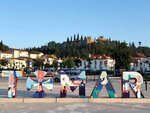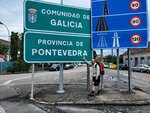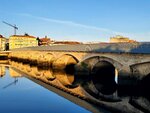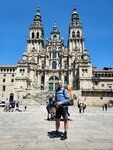








There are many pilgrim paths to Santiago de Compostela; however, there is only one route through Pontevedra, Spain.
I chose to walk the central route of the Camino Portugués for this exact reason. As a resident of Ponte Vedra, Florida, learning about my city’s namesake in Spain turned out to be a rewarding opportunity.
The Way of St. James, the Camino de Santiago or simply the Camino, is a network of pilgrimage routes all leading to the tomb of the apostle St. James the Great in the Cathedral of Santiago de Compostela. More than 400,000 people last year completed the journey. Since the movie “The Way” starring Martin Sheen premiered in 2010, it has become more popular with Americans.
The Camino Portugués is a different and shorter route than the more popular Camino Francés. Some people start the Camino Portugués in Lisbon, Portugal; however, the early going of that 400-mile journey is not very picturesque.
Alternatively, most start further north in Porto, Portugal, as I did, shortening the route to about 160 miles. You pass through Pontevedra, Spain, about three days prior to ending in Santiago de Compostela.
Getting the vibe
My personal route would be unconventional. I flew into Lisbon and decided it was important to acclimate myself to the culture versus starting to walk the Camino immediately.
As a historian, I found the ancient town of Tomar, Portugal, the most alluring introduction. After a short bus ride to Tomar, I took my first photo at the city sign with the Castle of the Knights Templar on the hill in the background. This really felt like old Europe, and I was thrilled to traverse the city with my backpack seeing the sites.
I enjoyed this style of immersion, so I decided to repeat the process further north in Coimbra, Portugal. Carrying my gear on a self-guided familiarization tour was like a Camino dress rehearsal. I decided to take breaks whenever a church was along my path, entering respectfully to say a prayer.
There is an exciting vibe in Coimbra given it is the home of the oldest academic institution in Portugal, the University of Coimbra, which dates back to 1290. I spent a day touring the university buildings and was enthralled by the splendor of the ancient Joanina Library. Apparently at the old Academic Prison, the longest sentence ever handed out was for destroying a book.
I spotted a tower in the courtyard and wondered how I could get to the top. Turns out, it is not always open and is not part of the regular ticket. For an extra Euro ($1.10 US) on my ticket, I learned it was possible. The circular stairwell was narrow with only one person at a time allowed on the 112-foot climb. The view was certainly well worth the price of admission.
Up until this point, I stayed at inexpensive hostels, which I booked last-minute using the popular Booking.com app. A big part of my Camino education would come from the pilgrims who had already started their journey. I knew they would be staying at these same hostels while making their way north by foot. For the price of a beer or two, I would hear the good, the bad and the ugly from these experienced travelers.
From Ponte Vedra to Pontevedra
The next day I made the jump to the city of Porto, Portugal, via train. When I arrived, I could not start my Camino fast enough. My acclimation period was over. I was ready to go: physically, mentally and spiritually. My inner voice had returned like an old friend and was ready to accompany me on this long-awaited journey.
I say “long-awaited” because I had been training in Ponte Vedra the past six months. Neighbors have been witness to a man carrying a heavy green backpack around the Walden Chase neighborhood loop for many months. On weekends, my wife helped with cardio by suggesting we add long walks on the beach finding shark’s teeth along the way. Getting to Mickler’s before 8 a.m. was a requirement, and I always remembered to bring that old pill container that served as our shark’s-tooth receptacle.
Hill training is important, and Ponte Vedra has only one practice venue, the Palm Valley Bridge. As you drive over the bridge and see people carrying backpacks you now know there is a purpose to what seems to be an oddly placed hiker with no apparent destination.
For the next five days, I would be in Portugal walking about 16 miles a day. I proudly wore a scallop shell on the outside of my backpack signaling I was a pilgrim on the Camino. The scallop shell is the emblem of St. James.
Before long, I had crossed a bridge and was in another country. I entered Spain at the town of Tui and to my surprise saw my first Pontevedra sign. Like a huge advertisement, I realized I was in the Province of Pontevedra. Evidently, Pontevedra is not just a city, but also a much larger province of around a million people along the Atlantic Coast.
Meeting fellow pilgrims
At this point of my spiritual journey, Camino miracles were happening every day.
Upon arriving in Spain, I thought, wouldn’t it be nice if someone could be there to document this milestone with a photo? To my surprise, I had caught up to my “Camino brothers,” Carlos and Juan Carlos, at that exact time. My pilgrim friends from Spain were happy to take my photo next to the “Provincia de Pontevedra” sign.
Our get-together warranted a mini celebration. By this time, I was missing a regular Guinness at our local Fionn MacCool’s, so when I saw an Irish pub in the distance, our reunion venue was determined. While I savored my liquid treat thinking of Ponte Vedra, I mused, Mel still has the best pour with a Guinness Perfect Pint trophy to prove it.
It is worth mentioning I was on a solo journey; however, when you are roughing it with other kindred spirits, you naturally bond along the way. We were all staying in the no-frills, pilgrim hostels called albergues. After several evenings of meeting up, some pilgrims become your Camino family. Sometimes there is only one restaurant open in the town, so you all end up at the same place for a night cap. I never started my day walking with anyone, yet I always met fellow pilgrims along the way as our pace would vary throughout the day.
I spent the next several days walking through the Province of Pontevedra spending nights in the towns of Tui, Mos, Pontevedra and Caldas de Rios on the way to Santiago de Compostela. The Province of Pontevedra is one of four provinces that make up the even larger autonomous community of Galicia. The part of Spain that sits on top of Portugal like the top figure of a totem pole is Galicia.
As I approached the city of Pontevedra, my inner voice was coming through more loudly and clearly. Each morning I was up early looking forward to the long walk on the trail outside to find the pathway inside.
My confidence was building. For the first time, I was sure my 60-year-old body was going to make it all the way to end. The months of preparation were now bearing fruit because I was feeling better each day and was open to the more valuable life lessons ahead.
Matters of nomenclature
On the seventh day of the Camino Portugués, I was up at 6 a.m., preparing for the walk to Pontevedra, Spain. This more aggressive decision meant I was skipping a stage on the Camino and almost doubling my daily mileage. With the collective energy from my Camino brothers, we walked over 20 miles. Our destination was the albergue (pilgrim hostel) on the southern outskirts of the city of Pontevedra, the provincial capital of the province with the same name.
The name Pontevedra became much more commonplace along this section of the Camino. It is the name of the entire province, the capital and the large estuary (Ria de Pontevedra) that connects the city to the ocean. The estuary leads to Rio Lérez, the river that cuts through Pontevedra, Spain.
This is one geographic similarity we have with our city’s namesake in Spain. In North Florida, we have an estuary with the Guana River cutting into Ponte Vedra Beach and the Tolomato River penetrating Nocatee. The same aquatic birds such as cormorants, herons and seagulls can be found at the estuary in both Spain and Florida.
My favorite parts of the Camino were sections showing signs from the Roman days. The planners of the Camino intentionally take you over the old Roman roads. The oldest bridge in Pontevedra, called the Burgo Bridge, was built at the site of an earlier Roman bridge. This current stone bridge dates back to at least 1165 — so, one can say, from the medieval period. The Burgo Bridge has sculpted scallop shells in the 10 visible arches, a tribute to the centuries of pilgrims who have made this river crossing.
This leads me to the origin of the name Pontevedra. There are two theories. The more prevalent theory is a composite of Latin words; Pons or pontis translates to bridge; and veter, vetera or veterum translates to old and long-established.
So, basically, the Spanish city gets its name directly from the old Roman bridge. A more recent theory has connected the name to an ancient Latin translation of green sea since there could have been green seaweed tides at one time when the river was wider.
So, how did we get the name Ponte Vedra in Florida? First you have to go back to the Mineral City days when the National Lead Company, successor to the Buckman and Pritchard Mining Company, decided to discontinue mining and develop a residential area. They wanted a more attractive name than Mineral City.
Colonel Joseph Stehlin was in charge of the new development. He and his wife did some research on names in Spain given the Spanish roots of our area dating back to the founding of St. Augustine in 1565. Our Ponte Vedra Beach area was first called Diego Plains by the Spanish; however that name was unsatisfactory to the new planners.
For marketing purposes, they proposed Ponte Vedra after finding the Spanish city of Pontevedra in the local library.
Later Stockton, Whatley, Davin & Co. (SWD) became the owners of the Ponte Vedra Corporation, and they made significant advances in the 1930s to develop the area of Ponte Vedra Beach. I once heard it was an employee of SWD who proposed the name Ponte Vedra after reading an article about Christopher Columbus. The flagship for Christopher Columbus was “The Santa María” (originally named “The Galician”), the largest of his three ships on his first voyage, which was built in Pontevedra, Spain.
While the connection between Columbus and Pontevedra, Spain, is true, the connection with SWD and the origin of the name Ponte Vedra, Florida, appears to be a myth since the name had already been decided.
Exploring the city
After getting settled at the albergue, my Camino brothers and I set out to explore Pontevedra. On the south end, it appeared more like a modern city with high-rise apartments and an ALDI discount supermarket. Then we followed the familiar yellow arrows of the Camino that led us into the older part of the city.
The first major site we passed was the Shrine of the Virgin Pilgrim. It was built at the end of the 18th century to honor the patron saint of the province of Pontevedra and the Portuguese Pilgrimage Route to Santiago de Compostela. High in the façade, St. James and St. Joseph, wearing their pilgrim clothes, flank the statue of the Virgin. This beautiful shrine filled with pilgrim symbolism remains a testament of how important the St. James Way or Camino is to the city.
This is clearly one of the most pedestrian-friendly cities I have ever visited. There are three plazas or squares just around the Shrine of the Virgin Pilgrim. One is called Plaza da Ferraría, and it was large enough to accommodate a fair with bullfights in the 17th century. We walked through a dozen plazas; each one accompanied by artwork, statues, or bordering historic buildings.
The best part about the plazas was the activity of the outdoor cafés.
At 8 p.m., people started coming out for dinner. My friends and I always ate outside at one of these plaza cafés. The small tables covered with umbrellas were perfect for a party of four in any weather. We had three basic requirements when choosing a restaurant: an open table, free tapas and a varied menu. The free tapas or savory snacks were easily identified. If you saw the same plates of tapas on multiple tables, most likely that was delivered for free along with your first paid drink. We typically ordered additional tapas when we decided to have more than one drink. Dinner at the same place was optional for us.
Structures of the past
As the day was ending, we moved on to see more of the old city. We took photos by the old Burgo Bridge while the sun was at an optimal angle. There was a beautiful reflection of the bridge in the river that evening.
On the south side of the bridge, there was a fenced-off area. It was part of the original medieval bridge. I looked into the excavation to see a partially buried arch of the bridge and a section of the medieval pier visible behind the barrier. This was part of a larger archaeological dig, which uncovered three Roman milestones dated between the second and fourth centuries. It was exciting to hear Pontevedra was still uncovering secrets of the past.
It was time for dinner, so we made our way back toward the cafés and up a different street toward the city’s principal church. To our surprise, we walked around the outside of an original city wall. Like so many other ancient cities, Pontevedra was once a walled city. The high stone walls led to the Basilica of St. Mary. In the past, a section of the city wall was destroyed to build a wide staircase from the lower street up to the front of the Basilica. We decided to eat at a café while looking up at the beautifully carved Western façade of the church in perfect view. Later, our concerted creativity was put to the test since the gate to our albergue was locked by the time we called it a night.
The more I learned about Pontevedra, the more questions I needed answered. I decided to go back, after the Camino, to spend more time getting to know the namesake of my hometown. The extra days back in Pontevedra would prove to be the most enlightening.
160 miles later
It took me just 10 days from the time I started in Porto, Portugal, to walk the 160-mile Camino Portugués to Santiago de Compostela, Spain.
As you enter the city, pilgrims from all the different Camino routes gather at the square on west side of the Cathedral of Santiago de Compostela. Looking up at the magnificent façade, you see Saint James the Great, one of the apostles, looking down at you from his niche in the central tower.
For me, the ending was an odd combination of exhilaration and relief. Sure, I was excited to be at the Cathedral; however, I was equally relieved to have safely arrived given the rugged pace of my Camino brothers who were half my age.
Santiago de Compostela is an inspiring city brimming with pilgrims, musicians and tourists. Even if you never walk a Camino, it is well worth a visit to enjoy the culture. I stayed a total of four nights in the city doing several tours, including ones inside and outside of the Cathedral. At one of the Masses I attended, I was blessed to have witnessed the Botafumeiro (giant incense burner) sacredly swung above the congregation.
From a physical perspective, I could boast I completed the Camino, however from my spiritual side I knew it was a beginning. My thoughts focus more on the importance of the journey, versus the destination.
Tale of two cities
With a few extra days remaining on my trip, I decided to go back to Pontevedra, Spain. I had walked through it on the Camino many days ago; however, this time I would explore it more thoroughly with the intention of filming and creating a presentation. On the return visit, I picked a hostel in the older part of the city near the 16th century basilica. Talking with locals helped me to delve deeper into the culture of the city. To my delight, my Castilian Spanish, which I learned at school in the U.S., was better understood here because of the mixed Castilian and Galician dialects in this part of Galicia.
Pontevedra is truly a pedestrian-friendly city. It seems like the entire historic district is vehicle-restricted. With my GoPro camera, I taped the walk across four bridges; two of them were pedestrian-only, including the medieval Burgo Bridge. The city has won international awards for urban planning and sustainable development. In 2016, they were even recognized as one of the best cycling cities in the world.
I wondered why I had not heard more about Pontevedra. Why didn’t any of my guidebooks recommend it as a preferred city if you needed a Camino rest day? Amongst my fellow pilgrims, there was no talk of Pontevedra’s significance regarding the Camino or of the awesome nighttime food scene. The city seemed optimal for tourism; however, it was one of those best kept secrets. Turns out, the majority of Pontevedra’s tourists come from Spain and Portugal.
It occurred to me, Pontevedra was more like Ponte Vedra, a great place to live, versus a tourist destination. Pontevedra had tourists, however I would call it more of a cultural destination than a touristy one. The gaudy components of tourism were not present. I savored the self-guided approach with information gathered from a tourism kiosk.
As a resident of Ponte Vedra and North Florida, I chose to live here for the quality of life. I found similar beneficial characteristics in the city of Pontevedra, Spain.
Both of our areas have desirable weather conditions. The proximity to the ocean has a moderating effect on the climate, so it does not get too hot or too cold. We both have rainy seasons — just at different times of the year.
Our North Florida area is growing as people discover what our area has to offer. Pontevedra is also growing — just at a much slower rate.
Rivers are part of our North Florida culture, and our bridges play a major role in our transportation. Jacksonville has seven bridges crossing the St. Johns River. Likewise, Pontevedra is a river city with seven bridges crossing the Lérez River. The modern Tirantes Bridge in Pontevedra is a cable-stayed bridge resembling a smaller version of our Dames Point Bridge. Water activities such as kayaking and rowing can be seen in both of our areas. Pontevedra even has beach areas along their river.
The North Florida and Pontevedra, Spain, areas are blessed with the energy of youth. Both have a university influence and student population. Jacksonville is the city with the youngest population in Florida. Pontevedra is the city with the youngest population in Galicia.
We enjoy a pedestrian-friendly area and being able to walk around at night in active, safe areas like St. Augustine, Fernandina and the Atlantic Beach Town Center. Nocatee is a planned community with many walking paths through natural areas. Pontevedra is the ultimate city for pedestrians. Everyone walks everywhere. Everything is accessible. I wandered through dozens of picturesque streets past 20 monumental sites and public gardens. At night, it seemed like everyone was eating out and enjoying the clean, public gathering spaces or plazas throughout the city.
Our local Riverside area has Five Points, which is fairly unique. In comparison, Pontevedra has Cinco Calles plaza where five pedestrian streets come together. This was one of my favorite plazas. The narrow stone streets were bordered by buildings, two and three stories high, constructed to the edge of the street. They joined at an open-air plaza with several restaurants and outdoor seating. This was just one of the 16 plazas I visited in Pontevedra.
I would say our area has a Christian influence, as does Pontevedra. I personally conduct North Florida church tours arranging for guests to see eight of our local treasures rich in architecture. Just in the old town area of Pontevedra, there are eight major religious sites with published times to visit for free. One sacred site I visited was the Shrine of the Apparitions. Sister Lucia, one of the three famous Fátima children to see the apparitions, lived in Pontevedra in a convent/school, later in her life. Her room was converted into a chapel.
We have statues in our area with the most recognized being the General Andrew Jackson equestrian statue depicting him in 1815. Jackson is portrayed with his chapeau de bra (hat) during the Napoleonic era. When I first saw the Monument to the Heroes of Ponte Sampaio in Pontevedra, I immediately recognized the familiar chapeau de bra from the Napoleonic era. The monument commemorates their victory against the French in 1809.
There were many other fun comparisons I noticed. We both have sport teams, local stadiums and an annual jazz festival. Jacksonville and Pontevedra, Spain, each have eight sister cities with twinned cities in Brazil, Argentina and the Caribbean. We have an underground tour of Jacksonville called, “Top to Bottom.” Pontevedra has an underground museum where you can see remains of the ancient city.
I’m home conducting tours again and reminiscing about my spiritual days on the Camino while training for the next journey. Feel free to give me a friendly honk when you see the green backpack walking across the Palm Valley Bridge in the morning. The afternoon, however, is reserved for siesta, the one piece of Spanish culture this senior carried home.
Gary Sass is a local historian and owner of Jacksonville Walking Tours and AdLib Luxury Tours. He enjoys public speaking and freelancing as a Journey Writer.